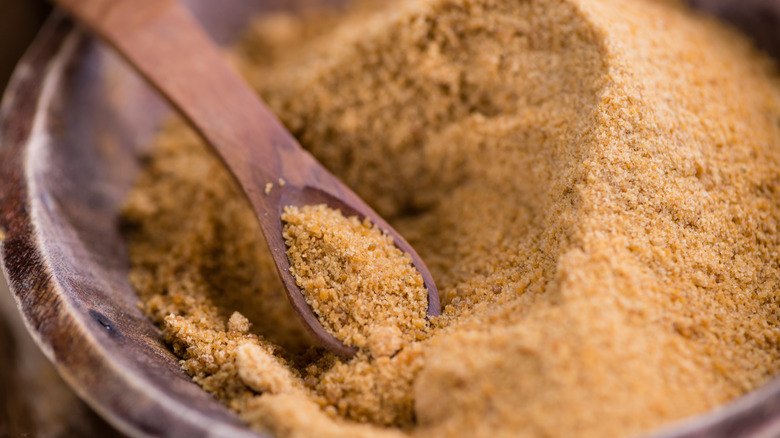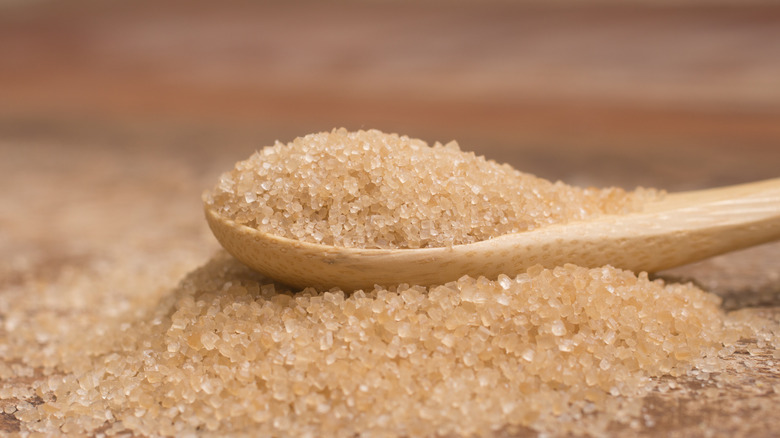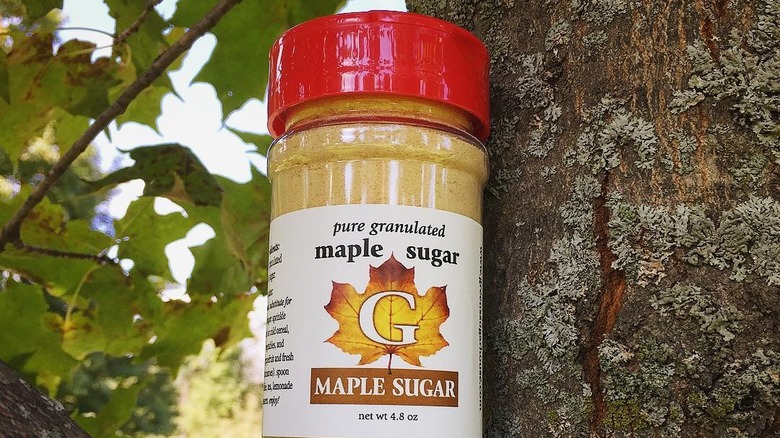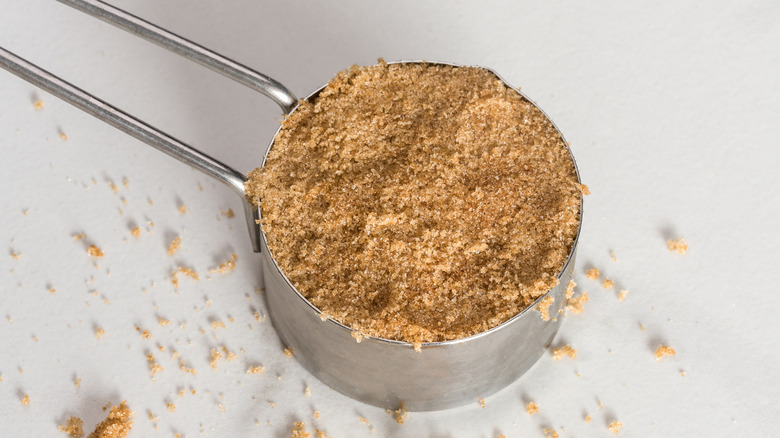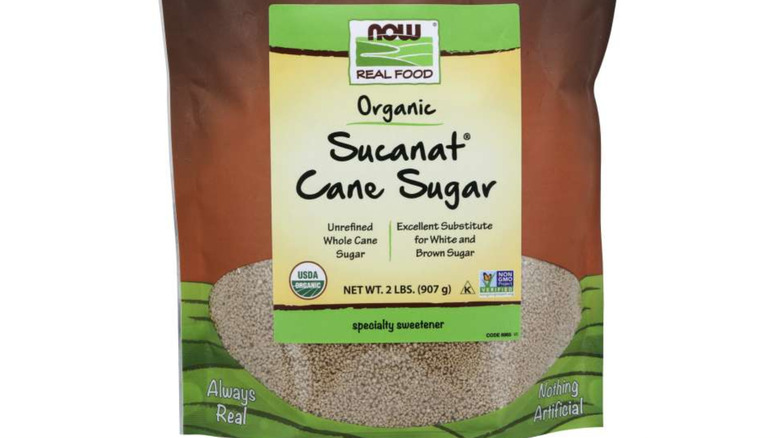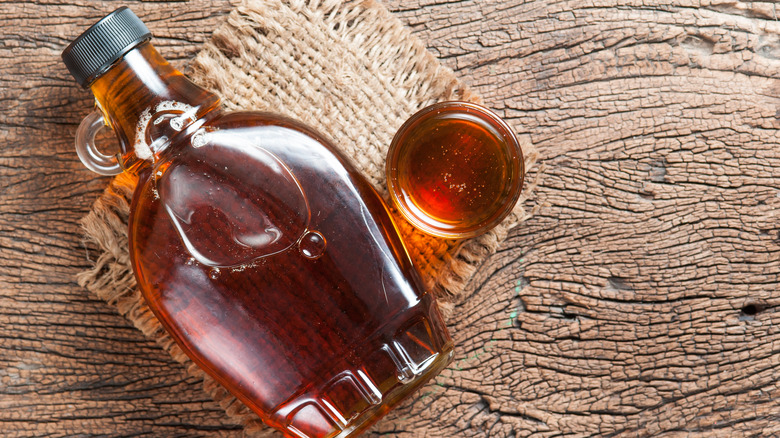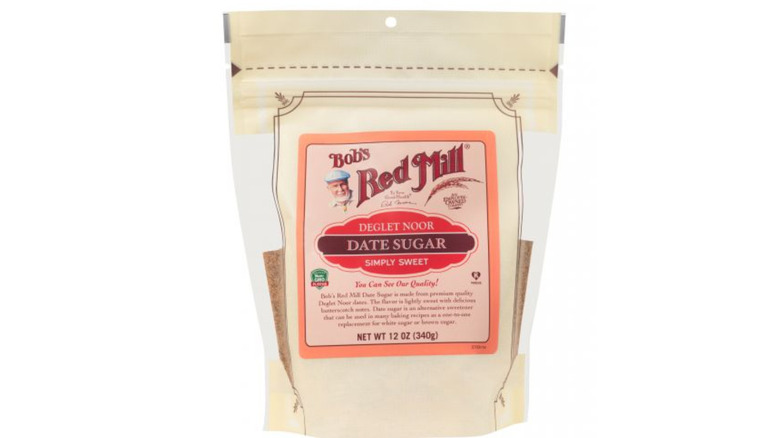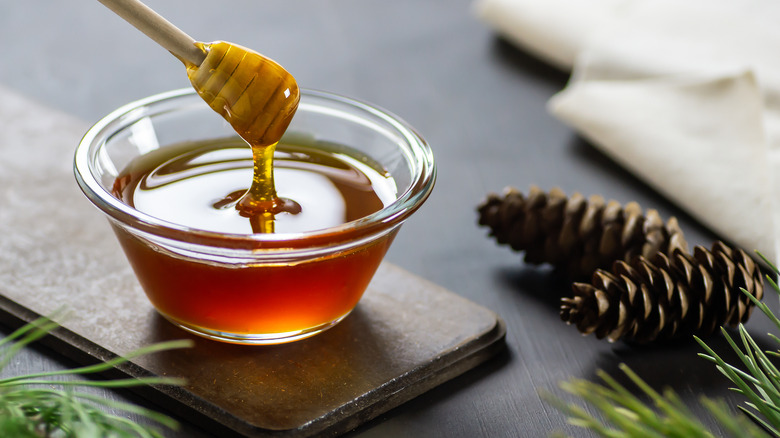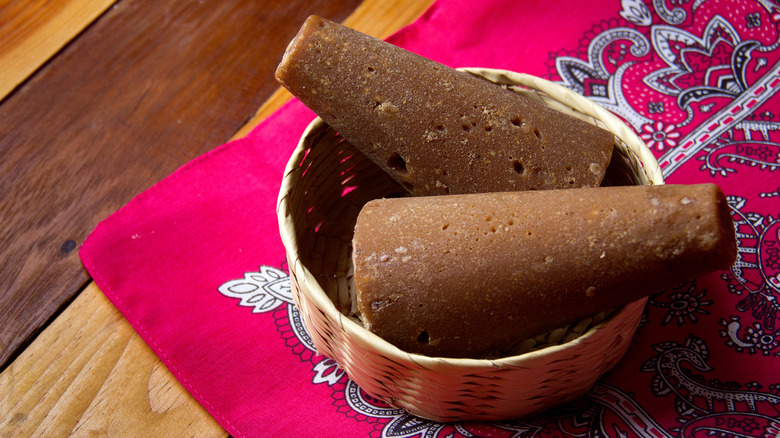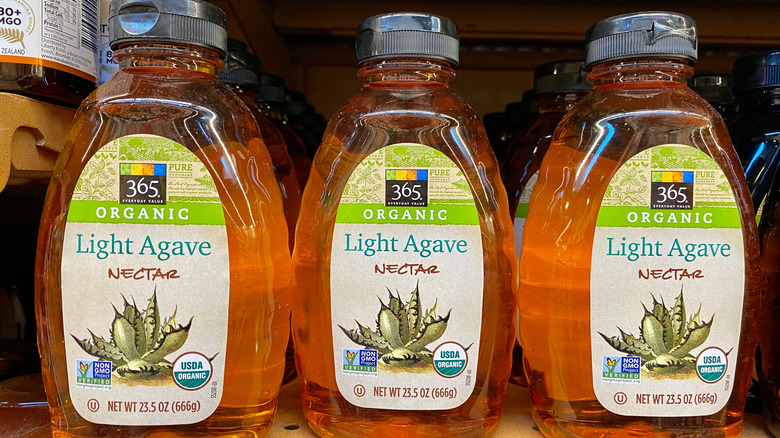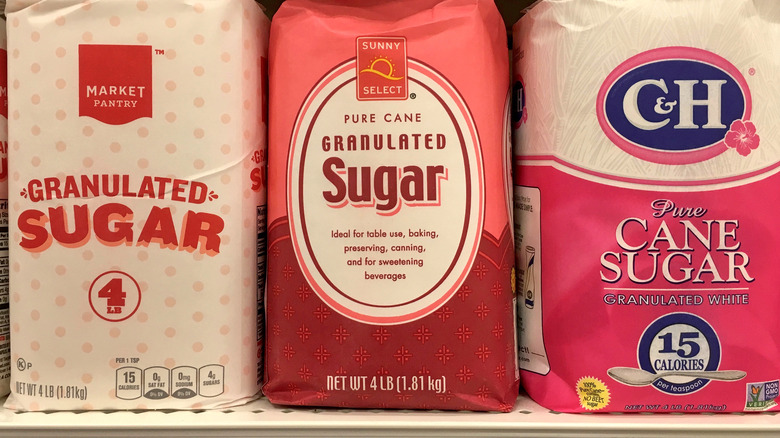10 Best Substitutes For Coconut Sugar
Thanks to a good amount of attention in recent years, coconut sugar is much easier to find in stores now than ever before. The reason for the hype surrounds its reputation as a healthy replacement for white sugar. And while coconut sugar does have a lower glycemic index, meaning it doesn't create such intense energy spikes and resulting crashes like regular sugar is prone to do, it should be known coconut sugar still has a lot of fructose and the same number of calories as white sugar, according to Healthline.
It may also surprise you to learn that coconut sugar isn't made from an actual coconut. According to Bon Appétit, it's rather created by gathering sap from flower stems on coconut trees. The sap is then boiled down, and the resulting mass is ground to make a sugar, with a coarse texture and darker color that looks similar to common brown sugar. The resulting flavor is similar to a mild caramel, with a "slight earthiness." Coconut sugar can be used in many of the same ways as granulated sugar, like blending it with butter to use in baked goods, dissolving it to make a simple syrup, or simply sprinkling or stirring it into dishes.
However, home cooks know there are always those days when you're deep into a recipe and suddenly discover you're out of something, very often times your sugar source. And for those looking for other healthy sweetener alternatives, it's good to know there are a large number of substitutes you can use to replace coconut sugar if needed.
1. Turbinado Sugar
Turbinado sugar is a pale brown, coarse sweetener with granules that are larger than typical white sugar. Sometimes the name is used interchangeably with demerara sugar, although they are two different types. Demerara sugar has about half the amount of molasses that turbinado sugar has, and slightly larger crystals. Both types are less processed than white sugar, with naturally occurring molasses and trace nutrients remaining. Although some companies like to label these two types as raw sugars, Healthline points out that's not really true, since truly raw sugar is inedible!
Turbinado has a mild flavor of molasses or caramel, and in that way, it's similar to coconut sugar. The crystals tend to keep their shape when warmed up, which means it's a good substitute to use when you want to give dishes a rustic, even sparkly look — like sprinkled over fruit crisps, pies, cookies, bars, and even roast vegetables. This type of sweetener also works well in dry rubs for meats. Since both coconut sugar and turbinado sugar give baked goods a drier, crumblier texture, turbinado is a good substitute in batter for baked goods, especially recipes that will naturally have a lot of moisture from the other ingredients.
According to Bake It With Love, you can use the same amount of turbinado sugar as you would coconut sugar in a recipe.
2. Maple Sugar
Maple sugar has many things in common with coconut sugar, and can be a worthwhile substitute. SPICEography shares that maple sugar is made by harvesting and then boiling down the sap of maple trees — just as coconut sugar is made from the sap of coconut palm trees. Maple sugar also is a result of the same process that is used to create pure maple syrup, except that a longer cooking time is required to reduce the sap to crystals. This means that both coconut and maple sugars are minimally processed, which leaves the color and flavors intact.
Maple sugar's subtle caramel notes are also like coconut sugar — the taste is accompanied by a rich maple flavor and even a slight butteriness. Bulk availability in grocery stores will vary, but farmers markets with regional maple producers can be a good bet to find some, as are natural foods stores and baking stores. SPICEography says that you can do a straight 1:1 swap of maple sugar for coconut sugar in most recipes. However, it's always worth enjoying pure maple products in recipes where the flavor will be front and center, like stirred into hot drinks or dusted over baked goods.
3. Light Brown Sugar
Light brown sugar is an excellent substitute to use when you don't have coconut sugar on hand, or want to try something new. SPICEography says light brown sugar is about the same color as coconut sugar, and it has a very similar flavor with notes of mild caramel. Brown sugar in general is made with refined white sugar and some molasses added back in for moisture, color, and flavor. You can find brown sugar in light and dark varieties, but a lighter color option is the closest match to coconut sugar.
Use a 1:1 ratio with this swap too, so apply the same amount of cups, teaspoons, or ounces of light brown sugar as you would coconut sugar in your recipe. It's an ingredient often called for in baked goods, and so it's an ideal substitute in recipes for cookies, muffins, and bars. To that point, SPICEography notes that light brown sugar is just a little bit sweeter than coconut sugar. So, for mixing into drinks or sprinkling over dishes where you'll really notice the difference in sweetness, use two teaspoons of light brown sugar for every three teaspoons of coconut sugar that's called for — once you taste your dish, you can add more as you like.
4. Sucanat
The name Sucanat is a shortened, trademarked version of "sucre de canne naturel," which means natural cane sugar, according to SPICEography. Although Sucanat is made from sugar cane just like white and brown sugars, it's created through a much different process.
According to America's Test Kitchen, much of the processing of white granulated sugar happens in a factory, as the sugar cane juice goes through multiple stages of heating, filtering, and clarifying. The process to create Sucanat, however, is more straightforward: sugar cane is pressed through rollers to extract the juice, which is then beaten by hand with paddles to create crystals. The resulting sweetener is light brown in color with a coarse texture, and the crystals don't have the sparkly look that other granulated sugars have. Because it's less refined, just like coconut sugar, more of the naturally-occurring molasses is retained in Sucanat, giving it color and more flavor, too.
America's Test Kitchen recommends grinding Sucanat in a spice grinder before using, because it doesn't easily dissolve in liquids or in batters — so the smaller the granule size, the better. For every cup of coconut sugar called for in your recipe, use 3/4-cup plus two tablespoons of Sucanat. It's a preferred sweetener to use in baked sweets like cookies and brownies because of the molasses-rich flavor it imparts.
5. Maple Syrup
The sweetness and irresistible flavor of maple syrup can work well as a substitute for coconut sugar, though it's not a straight swap the way maple sugar is. Maple syrup is a liquid, of course, made from the sap of trees. The sap is boiled down to evaporate most of the water away and to create maple syrup (via Bake It With Love).
Maple syrup is available in four grades, which differ in color and in flavor. According to New England Today, the grades indicate how early or late in the season the sap was harvested: Grade A Golden and Amber are from sap harvested early, and Grade B Dark Amber and Very Dark are from sap near the end of the season.
Vermont Maple Sugar Makers recommends that for every cup of coconut sugar needed, you can substitute 3/4-cup of maple syrup. Additionally, cut other liquids in your recipe back by 1/4-cup to compensate for the moisture in maple syrup. If you're using this pick as a substitute in baked goods, lower the baking temperature by 25 degrees to prevent over-browning as well. This swap will work for any grade of maple syrup, but the one that's closest to coconut sugar for flavor is Grade A Golden, which has a mild, subtle taste.
6. Date Sugar
This substitute is actually not a sugar at all, but it does have plenty of sweetness and flavor that can stand in well for coconut sugar. The Kitchn says that date sugar is made from whole dates, which are dehydrated and then ground into a powder. As such, it has a deeper brown color than coconut sugar, with a texture that's a mix of coarse and sandier particles. It shouldn't be confused with date palm sugar, which is made from the sap of palm trees (on the contrary, date sugar is just pulverized dates).
The flavor is like that of butterscotch, with notes of caramel. You can use an equal amount to replace coconut sugar in your recipe. Because it's dehydrated fruit, it won't dissolve in liquids or wet batters the way sugars easily do. But, date sugar can be softened in boiling water before using, or just use it the way it is, though you may see tiny flecks of brown in your finished dish or sediment at the bottom of drinks. Date sugar will also add color when used to sprinkle over baked goods, and it's also very tasty when used in spice rubs for meats.
7. Honey
When you're looking for a natural and unrefined substitute for coconut sugar, honey is an excellent choice. It doesn't have the light caramel flavor that's so appealing in coconut sugar, but instead it has sweetness laced with floral notes. This makes sense, since bees have worked so hard to gather all that nectar! Since it's a liquid sweetener, like maple syrup, for the amount you use, you will need to take into account the added moisture.
To get the purest product, consider using raw honey, which has been strained from the honeycombs directly into bottles. Using a raw type means you won't end up with adulterated honey, a practice where some producers put additives or other, cheaper sweeteners inside the bottle. If you want to go even further and acquire pasteurized pure honey, get to know and buy from local beekeepers in your area.
For guidelines on using it as a replacement, The Kitchn recommends swapping in anywhere from 1/2-cup to 2/3-cup of honey for every cup of coconut sugar called for in a recipe. For baked goods or other dishes where the amount of moisture will affect the final outcome, you should also reduce other liquids by about 1/4-cup. To sweeten drinks, though, you can stir in an equal amount of honey.
8. Piloncillo
These dark brown, solid cones of sugar are sometimes sold as panela or Mexican brown sugar. Piloncillo is made by boiling raw cane sugar down into a thick, dark brown liquid. It's then poured into molds, left to harden, and then popped out to reveal the conical shape. This simple method means it's a great choice if you're looking for an option that, like coconut sugar, is minimally processed.
The flavor of piloncillo is more pronounced than coconut sugar, though. It's often compared to regular brown sugar, where the flavor is more complex and intriguing: sweet of course, but with hints of molasses, rum, and burnt sugar. It's a great choice for all kinds of sweet and savory recipes. Look for plastic-wrapped cones or bricks of piloncillo at Latin American markets, and you may also find them in the international or Latin aisles of other grocery stores.
To use it, cut chunks from the cone using a sharp knife and then chop them to the size that best suits your recipe. Another option is to finely grate piloncillo with a microplane or box grater. If the cone is very hard, you can soften it by heating in short bursts in the microwave. Substitute Cooking suggests using an equal amount of piloncillo for the coconut sugar called for in your recipe, while keeping in mind that the flavor will come through a little more strongly.
9. Agave Nectar
Like maple syrup and honey, agave nectar is a liquid sweetener that you can reach for when you need a substitute for coconut sugar. Agave nectar comes from agave plants, a type of succulent native to the hot and dry climates of the South and Southwest. Sap is extracted from the plants and then heated to create the thick syrup, or nectar.
Bake It With Love suggests that when substituting agave nectar for coconut sugar, use ¼ cup agave syrup for each cup of coconut sugar. And because it's a liquid sweetener, you should also reduce the amount of other liquids in your recipe by about 20% to compensate. Agave is sweet but without much flavor, unless you find darker grades, which can have a flavor closer to that of honey.
Another thing to consider, according to Eating Well, is that agave nectar tastes sweeter than regular sugar. It's a great choice to add to drinks, sauces, and marinades, but you can probably get away with using a little less than you would normally use for coconut sugar because of this.
10. Granulated Sugar
One of the reasons that home cooks turn to coconut sugar is because it's a more natural sweetener made without all of the processing and stripping that goes into making white, granulated sugar. Many of the substitutes on this list, from maple products to honey to piloncillo, have this same advantage. They're still sugars, but because they're created with minimal amounts of processing, the natural flavors, colors, and even trace nutrients remain.
However, even if you're trying to eliminate white sugar in favor of coconut sugar, sometimes there are moments where you just need to get your recipe finished! If you're out of coconut sugar, but have granulated white sugar on hand (or a neighbor willing to give you some), it's an easy swap.
You can use the same amount of granulated sugar as coconut sugar in a recipe. It will have the same effect on the browning and sweetness of your baked goods, and granulated sugar will also melt and dissolve as easily as coconut sugar does. If you're sprinkling it over the tops of baked goods, keep in mind that granulated sugar crystals are more fine and will have a different texture and, of course, color.
